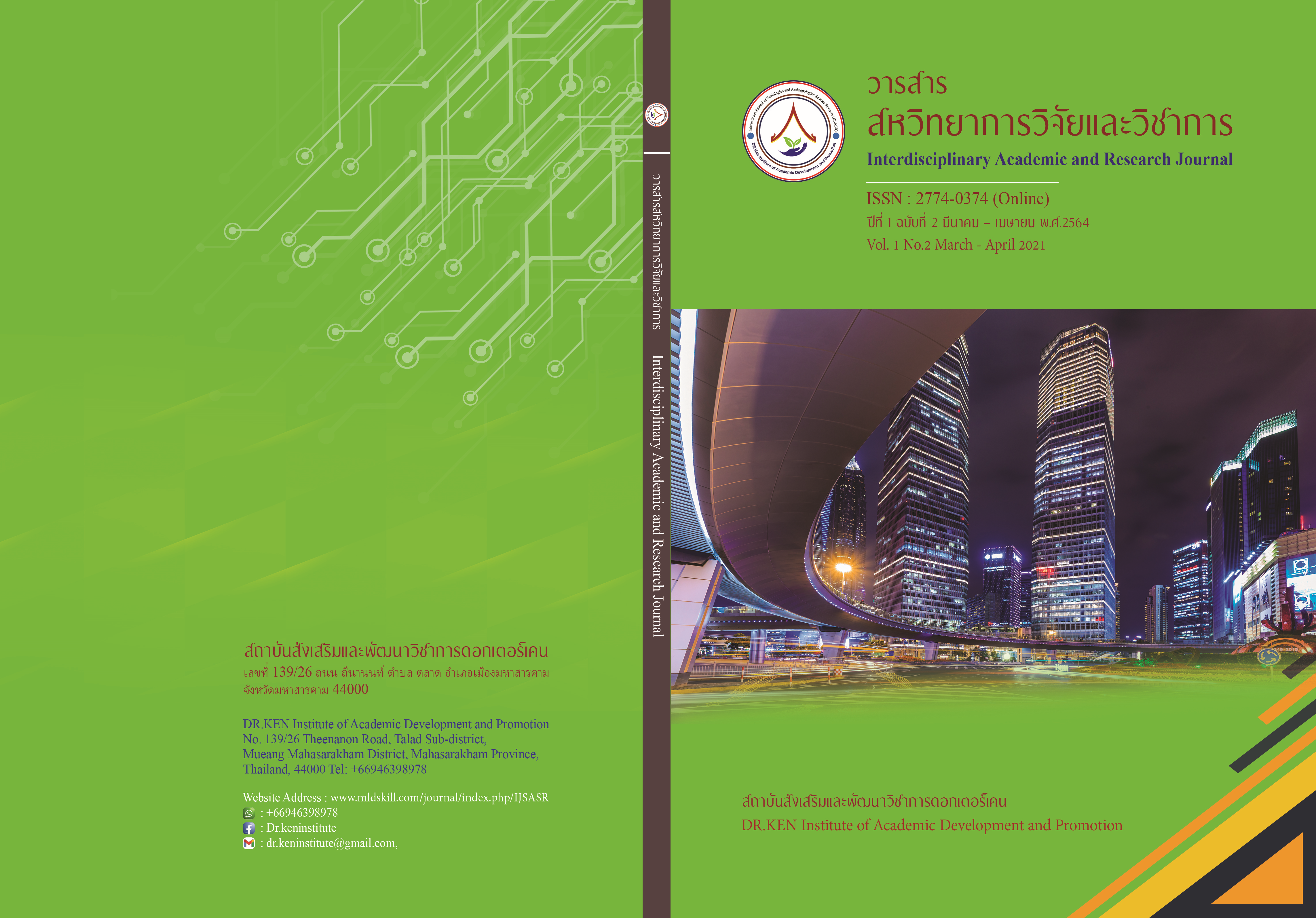Development of Internal Supervisory Model for Teacher Competency Improvement on English Learning Management for Secondary School in The Northeastern part of Thailand
DOI:
https://doi.org/10.14456/iarj.2021.6Keywords:
Internal Supervisory Model, Teacher Competency, English Learning ManagementAbstract
The research of Development of Internal Supervisory Model for Teacher Competency Improvement on English Learning Management for Secondary School in The Northeastern part of Thailand was purposed 1) to study current and desirable conditions of the teacher competency in English learning management for a secondary school in the northeastern part of Thailand; 2) to develop the internal supervisory model for teacher competency improvement on English learning management for a secondary school in the northeastern part of Thailand, and 3) to assess the internal supervisory model use for the teacher competency improvement on English learning management for a secondary school in the northeastern part of Thailand. This research and development were conducted in 3 phases, namely; phase 1: study current and desirable conditions of the teacher competency in English learning management for a secondary school in the northeastern part of Thailand. The sample group was 7 experts, together with 354 school administrators and English language teachers. The instruments used were the assessment form and questionnaire. Phase 2: develop the internal supervisory model for teacher competency improvement on English learning management for secondary schools in the northeastern part of Thailand with a sample group of 7 best practice experts for the interview, 21 specialists for criticism and model framework examination, and 9 experts for model affirmation. An instrument used was the assessment form. Phase 3: assess the internal supervisory model use for the teacher competency improvement on English learning management for a secondary school in the northeastern part of Thailand. Statistic Instruments used were Mean and standard deviation used for data analysis. The findings ;
1. The finding of the study of current and desirable conditions of teacher competency in English learning management for a secondary school in the northeastern part of Thailand showed that the current condition of the teacher competency in English learning management for a secondary school in practice, on the whole, was in the middle level. In addition, the desirable condition of teacher competency in English learning management for a secondary school in practice, on the whole, was at the highest level.
2. The result of the development of an internal supervisory model for teacher competency improvement on English learning management for secondary schools in the northeastern part of Thailand which passed the quality inspection of the internal supervisory model from the experts, consisting of 7 major elements as following; element 1 principle of the model; element 2 purposes of the model; element 3 operation mechanism; element 4 internal supervision content; element 5 internal supervision process consisting of Analyzing: A, Planning : P, Doing : D, and Evaluating: E, element 6 model assessment, and element 7 success condition of model application.
References
กระทรวงศึกษาธิการ. (2545). คู่มือการจัดการสาระการเรียนรู้กลุ่มสาระการเรียนรู้ภาษาต่างประเทศตามหลักสูตรการศึกษาขั้นพื้นฐาน พุทธศักราช 2544. กรุงเทพฯ : องค์การรับส่งสินค้าและพัสดุภัณฑ์ (ร.ส.พ.).
ชรอยวรรณ ประเสริฐผล. (2555). รูปแบบการพัฒนาสมรรถนะด้านการจัดการเรียนรู้ของครูใหม่โรงเรียนเอกชนประเภทสามัญศึกษา. วิทยานิพนธ์ กศ.ด. ปริญญาการศึกษาดุษฎีบัณฑิต สาขาวิชาการบริหารการศึกษา. พิษณุโลก : มหาวิทยาลัยนเรศวร.
ฐารินี นวลแหยม (2560). รูปแบบการพัฒนาครูเชิงปฏิบัติการผ่านวงจรคุณภาพ เรื่อง การสร้างแบบวัดการรู้ การอ่านส าหรับครูสังกัดส านักงานคณะกรรมการการศึกษาขั้นพื้นฐาน. วารสารมนุษยศาสตร์และสังคมศาสตร์ บัณฑิตวิทยาลัย มหาวิทยาลัยราชภัฏพิบูลสงคราม, 11 (2), 70-83.
ดิเรก วรรณเศียร. (2545). การพัฒนาแบบจำลองแบบสมบูรณ์ในการบริหารโดยใช้โรงเรียนเป็นฐานสำหรับสถานศึกษาขั้นพื้นฐาน. วิทยานิพนธ์ปริญญาครุศาสตรดุษฎีบัณฑิต สาขาการบริหารการศึกษา บัณฑิตวิทยาลัยจุฬาลงกรณ์มหาวิทยาลัย,
ธิดา ขันดาวงศ์.(2557). การพัฒนารูปแบบการนิเทศแนวใหม่เพื่อพัฒนาคุณภาพครูปฐมวัย สังกัดสำนักงานคณะกรรมการการศึกษาขั้นพื้นฐาน. วิทยานิพนธ์ ค.ด. (การบริหารการศึกษา) เชียงราย : มหาวิทยาลัยราชภัฏเชียงราย,
นิทัศน์ หามนตรี. (2557). การนำเสนอแนวทางการพัฒนาสมรรถนะครู สังกัดสำนักงานเขตพื้นที่ การศึกษาปนะถมศึกษาพระนครศรีอยุธยาเขต 1. วิทยานิพนธ์ครุศาสตรมหาบัณฑิต สาขาวิชาการบริหารการศึกษา, มหาวิทยาลัยราชภัฏพระนครศรีอยุธยา.
บุญชม ศรีสะอาด. (2549) “การพัฒนาการวิจัยโดยใช้รูปแบบ,” Doctor of Education. (Online). สืบค้นเมื่อ 9 มกราคม 2549. จากwww.edu.msu.ac.th/ead/Dr_Boonchom/websiteboonchom1/ publications/08.pdf
ปราโมทย์ วังสะอาด. (2558). รูปแบบการพัฒนาสมรรถนะด้านไอซีทีของผู้บริหารสถานศึกษาขั้น พื้นฐานสังกัดสำนักงานคณะกรรมการการศึกษาขั้นพื้นฐาน. ปรัชญาดุษฎีบัณฑิต, คอมพิวเตอร์ศึกษา : มหาวิทยาลัยราชภัฏมหาสารคาม.
ปรียาพร วงศ์อนุตรโรจน์. (2544). จิตวิทยาการบริหารงานบุคคล. กรุงเทพฯ : ศูนย์สื่อเสริมกรุงเทพ.
พัชรินทร์ ช่วยศิริ (2554). การศึกษาการดําเนินงานนิเทศภายในของโรงเรียนวัดประดู่ฉิมพลี. หลักสูตรปริญญาการศึกษามหาบัณฑิต สาขาวิชาการบริหารการศึกษา: มหาวิทยาลัยศรีนครินทรวิโรฒ.
ภักดี วงษาเนาว์. (2560). รูปแบบการพัฒนาครูเพื่อส่งเสริมการจัดการเรียนการสอนที่เน้นผู้เรียนเป็นสำคัญในสำนักงานเขตพื้นที่การศึกษามัธยมศึกษาหนองคาย เขต 21. ดุษฎีนิพนธ์ดุษฎีบัณฑิตสาขาวิชายุทธศาสตร์การพัฒนาภูมิภาค. บัณฑิตวิทยาลัย : มหาวิทยาลัยราชภัฏมหาสารคาม.
ยมนพร เอกปัชชา. (2557). การพัฒนารูปแบบการนิเทศแบบเสริมพลังเพื่อเสริมสร้างสมรรถนะการจัดประสบการณ์การเรียนรู้วิทยาศาสตร์ของครูปฐมวัย. วิทยานิพนธ์ ค.ด. ครุศาสตรดุษฎีบัณฑิต สาขาวิชาการจัดการการศึกษาและการเรียนรู้. นครสวรรค์ มหาวิทยาลัยราชภัฏนครสวรรค์,
วิสุทธิ์ วิจิตรพัชราภรณ์. (2547). การพัฒนารูปแบบการจัดการศึกษาแบบกระจายอำนาจในสถานศึกษาขั้นพื้นฐาน ตามแนวทางพระราชบัญญัติการศึกษาแห่งชาติ พ.ศ. 2542. กรุงเทพมหานคร : ฐานข้อมูลวิทยานิพนธ์ไทย.
วีระพันธ์ มาทมูล (2558). รูปแบบการพัฒนาครูเพื่อส่งเสริมพฤติกรรมการจัดการเรียนการสอนที่เน้นผู้เรียนเป็ นสำคัญของมหาวิทยาลัยมหาจุฬาลงกรณ์ราชวิทยาลัย วิทยาเขตในภาค ตะวันออกเฉียงเหนือ. ปริญญาปรัชญาดุษฎีบัณฑิต (ปร.ด.) สาขายุทธศาสตร์การพัฒนา ภูมิภาคคณะมนุษย์ศาสตร์และสังคมศาสตร์
สนั่น มีสัตย์ธรรม. (2542). ปัญหาการปฏิบัติงานของหน่วยศึกษานิเทศก์ ส านักงานการประถมศึกษา อำเภอ ในเขตการศึกษา 11. วิทยานิพนธ์ปริญญาการศึกษามหาบัณฑิต สาขาวิชาการ บริหารการศึกษา บัณฑิตวิทยาลัย มหาวิทยาลัยศรีนครินทรวิโรฒ มหาสารคาม
สมาน อัศวภูมิ. (2545). การบริหารงานบุคคล. กรุงเทพฯ : จุฬาลงกรณ์มหาวิทยาลัย,
สำนักงานคณะกรรมการการศึกษาแห่งชาติ. (2540). ระบบการประกันคุณภาพและมาตรฐาน การศึกษาแห่งชาติ. กรุงเทพฯ : พิมพ์ดี,
สำนักงานคณะกรรมการการศึกษาขั้นพื้นฐาน. (2553). คู่มือประเมินสมรรถนะครู ฉบับปรับปรุง. กรุงเทพฯ : สำนักพัฒนาครูและบุคลากรทางการศึกษา,
สำนักวิชาการและมาตรฐานการศึกษา สำนักงานคณะกรรมการการศึกษาขั้นพื้นฐาน. (2551). หลักสูตรแกนกลางการศึกษาขั้นพื้นฐานพุทธศักราช 2551. กรุงเทพฯ : โรงพิมพ์คุรุสภาลาดพร้าว,
Acheson, K. A. & Gall, M. D. (2003). Clinical supervision and teacher development: Preservice and inservice applications. John Wiley and Sons : USA.
Meason, Albert and Khedourri (1985). Management. New York: Harper and Row.
Barrett, A. M. & Scott, K. R.. (2007). Dementia syndromes: Evaluation and treatment. Expert Review Neurotherapeutics, 7 (4), 407-422.
Boyan, N.J., & Copeland, W.D. (1978). Instructional supervision training program. Columbus, OH: Charles E. Merrill.
Goldhammer, R., Anderson, R.H. and Krajewski, R.J. (1980). Clinical Supervision: Special Methods for the Supervision of Teachers. (2nd ed.). New York: Holt, Rinehart and Winston.
Gwynn, Minor (1974). Theory and Practice of Supervision. New York: Prentice-Hall.
Krejcie, R. V. & Morgan, D. W. (1970). Determining Sample Size for Research Activities. Educational and Psychological Measurement, 30 (3), pp. 607-610.
Willer, R.H. (1967). Leader and leadership process. Boston: Irwin / McGraw-Hill
Downloads
Published
How to Cite
Issue
Section
License
Copyright (c) 2021 Interdisciplinary Academic and Research Journal ISSN 2774-0373 (Online)

This work is licensed under a Creative Commons Attribution-NonCommercial-NoDerivatives 4.0 International License.
Copyright on any article in the Interdisciplinary Academic and Research Journal is retained by the author(s) under the under the Creative Commons Attribution-NonCommercial-NoDerivatives 4.0 International License. Permission to use text, content, images, etc. of publication. Any user to read, download, copy, distribute, print, search, or link to the full texts of articles, crawl them for indexing, pass them as data to software, or use them for any other lawful purpose. But do not use it for commercial use or with the intent to benefit any business.
















.png)


